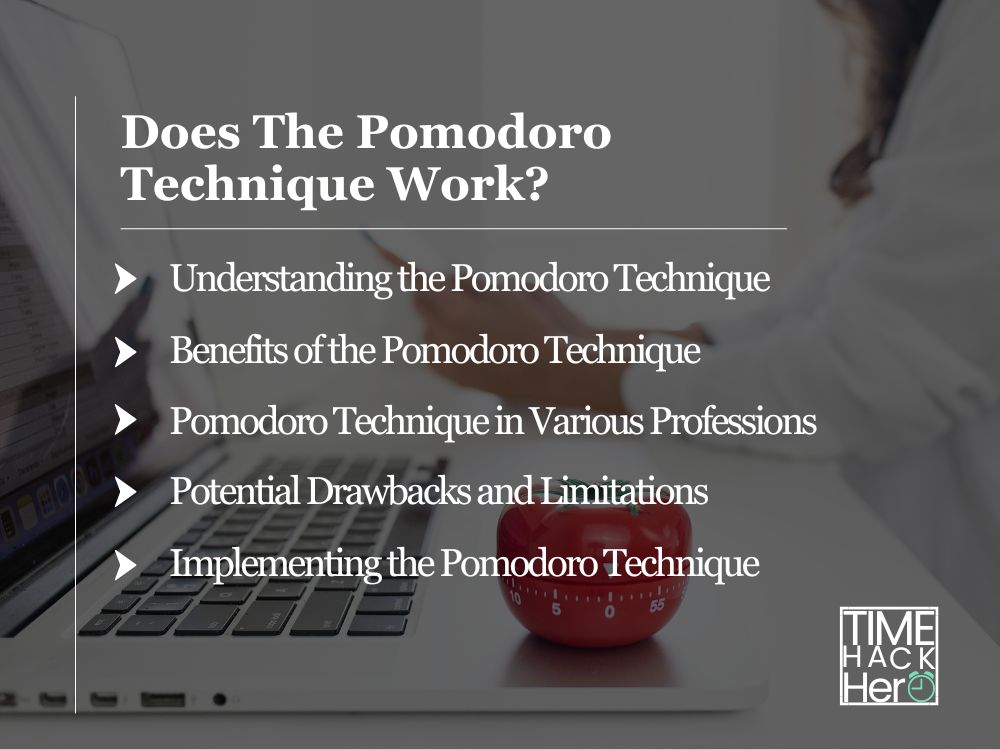In today’s fast-paced world, effective time management is crucial for success, and one popular technique to achieve this is the Pomodoro Technique. Developed by Francesco Cirillo in the late 1980s, this method utilizes a kitchen timer to segment work into intervals, typically 25 minutes long, followed by short breaks. Named after the tomato-shaped timer Cirillo used in college, the Pomodoro Technique has gained widespread recognition for its ability to enhance productivity and focus.
The core premise of the Pomodoro Technique lies in its structured approach to work, allowing individuals to concentrate on tasks for a set duration without distractions. The short breaks in between intervals give the brain an opportunity to rest and rejuvenate before resuming work, thus promoting a sustainable work rhythm that can potentially overcome procrastination and burnout. Furthermore, this technique encourages users to tackle tasks or projects in a more efficient and organized manner, which can lead to increased satisfaction upon completion.
However, despite its popularity and numerous benefits, it’s essential to evaluate if the Pomodoro Technique actually works for everyone. After all, not all tasks or individuals share the same demands or work styles. This article aims to delve deeper into the effectiveness of the Pomodoro Technique, exploring its strengths, potential drawbacks, and overall applicability in various contexts.
Table of Contents
Understanding the Pomodoro Technique
Origins and Purpose
The Pomodoro Technique is a time management method developed by Francesco Cirillo in the late 1980s. The technique was named after the tomato-shaped kitchen timer (pomodoro means tomato in Italian) that Cirillo used as a student. The main purpose of the Pomodoro Technique is to break work into manageable intervals, helping to improve productivity and focus.
The Basic Framework
To implement the Pomodoro Technique, follow these steps:
- Create a to-do list: Write down the tasks you intend to complete.
- Set a timer: Use a kitchen timer or any other timer for this purpose.
- Work in intervals: Focus on a single task for 25 minutes, known as a pomodoro.
- Take short breaks: After each pomodoro, take a 5-minute break.
- Track your progress: Mark off completed pomodoros and record what you have accomplished.
- Take longer breaks: After completing four pomodoros, take a longer break of 15-30 minutes.
By following these steps, the Pomodoro Technique helps you to:
- Maintain focus and concentration during work sessions.
- Prevent mental fatigue by scheduling regular breaks.
- Measure progress and promote a sense of accomplishment by ticking off completed tasks.
Benefits of the Pomodoro Technique
Increased Productivity and Focus
The Pomodoro Technique helps increase productivity by breaking work into manageable 25-minute intervals called “pomodoros” followed by short 5-minute breaks. This structure helps maintain focus and concentration throughout the work session and prevents distractions. The timer serves as a motivator to stay on task, as it provides a sense of urgency and a clear deadline for each interval. The regular breaks refresh the mind and minimize mental fatigue, further enhancing productivity.
Reduced Stress and Procrastination
One of the primary reasons people procrastinate is the feeling of being overwhelmed by the scope of a task. The Pomodoro Technique alleviates this stress by breaking tasks into smaller, manageable chunks. Additionally, the technique promotes taking regular breaks, which reduces mental fatigue and helps maintain a healthy, balanced level of stress. By encouraging individuals to focus on one task at a time, the Pomodoro Technique effectively reduces procrastination and feelings of being overwhelmed.
Improved Time Management and Planning
Using the Pomodoro Technique, individuals become more aware of their time allocation and the value of accomplishing work within a specific timeframe. By recording progress after each pomodoro interval, users develop a better understanding of how long tasks take, which aids in planning and making more accurate estimations. This improvement in time-management skills ultimately leads to higher efficiency and productivity.
Enhanced Work-Life Balance
The Pomodoro Technique offers a structured approach to work, which has particular benefits for those working from home. The clear delineation of work intervals and breaks helps establish boundaries between professional and personal life, allowing for more flexibility and a healthier work-life balance. By adhering to the scheduled break structure, individuals can rest and recharge, helping improve their overall well-being.
Pomodoro Technique in Various Professions
Students and Academics
The Pomodoro Technique can be particularly helpful for students and academics, as it promotes focused study sessions and regular breaks. The 25-minute work intervals can help students maintain their concentration on specific tasks, such as reading, writing, or solving problems. It also allows them to better manage their study schedules, prioritize tasks, and reduce the stress associated with cramming or procrastination.
- Reading: Breaking down lengthy readings into manageable 25-minute segments
- Writing: Organizing and composing academic essays or research papers in timed intervals
- Solving problems: Tackling complex problems or equations with short bursts of concentrated effort
Writers and Designers
Creative professionals, such as writers and designers, can also benefit from using the Pomodoro Technique, as it helps to establish a structured workflow and prevent creative burnout. By following the time intervals, writers and designers can maintain their focus and motivation, resulting in more productive and efficient work sessions.
- Writing: Drafting, editing, and revising content within the set timeframes
- Design: Allocating specific time for brainstorming, sketching, and elaborating on ideas
- Reviewing: Reflecting on and refining work during the scheduled breaks
Programmers and Researchers
For programmers and researchers, the Pomodoro Technique can be an excellent tool for managing complex projects and staying on track. By breaking down tasks into 25-minute intervals, individuals can better manage their time and allocate resources effectively. This approach helps maintain a healthy balance between work and breaks, leading to improved focus, increased productivity, and reduced stress levels.
- Coding: Working on discreet segments of code, such as implementing new features or fixing bugs
- Research: Reviewing literature, conducting experiments, and analyzing data within specific timeframes
- Collaboration: Utilizing the Pomodoro Technique in team projects to stay organized and maintain accountability
Potential Drawbacks and Limitations
Not Suitable for All Tasks
The Pomodoro Technique, while beneficial for many work tasks, is not always suitable for all types of activities. For instance, tasks that require deep, uninterrupted focus, such as complex problem-solving or creative work, might be hindered by the regular breaks imposed by the technique. Additionally, it may not be effective for tasks that have a variable time requirement, like attending meetings or dealing with urgent issues that demand immediate attention.
- Overlearning: In some cases, the Pomodoro Technique may lead to overlearning, where individuals spend excessive time on topics they have already mastered, resulting in a loss of overall productivity.
- Anxiety: The time pressure imposed by the 25-minute intervals may induce anxiety in some individuals, negatively affecting their work performance.
Disruption of Flow and Creativity
For tasks that demand continuous focus and creativity, the Pomodoro Technique might interrupt the flow state. This disruption can hinder the creative process, as it can take time to re-enter a state of deep focus after taking a break. Furthermore, the technique’s regimented structure could cause individuals to dwell on the time remaining in a Pomodoro interval, rather than fully immersing themselves in their work.
Inflexibility in Collaborative Environments
In collaborative work environments, such as team projects or brainstorming sessions, the Pomodoro Technique’s inflexibility can be a hindrance. Team members may find it challenging to synchronize their schedules, and the rigid timing could impede spontaneous collaboration. Additionally, the enforced breaks might disrupt valuable discussions and lead to a loss of momentum within the group.
- Working Smarter: In some cases, adhering to the Pomodoro Technique might limit opportunities for working smarter by constraining the exploration of alternative approaches to tasks.
- Balance: Maintaining a balance between work tasks and breaks can be difficult when collaborating with others, potentially leading to burnout or inefficiencies.
- Adaptability: The Pomodoro Technique may not easily accommodate changes in task priority or duration that commonly arise in dynamic team environments.
Implementing the Pomodoro Technique
Choosing the Right Timer
When starting with the Pomodoro Technique, it’s essential to choose the right timer. A simple kitchen timer, your smartphone, or an app specifically designed for the technique can work. The important thing is to find a timer that’s easy to use and doesn’t become a distraction. Some popular Pomodoro apps include Focus Booster, PomoDoneApp, and TomatoTimer.
Setting Goals and Priorities
Before beginning your Pomodoro session, create a to-do list with the tasks you want to complete during your focused work intervals. This helps prioritize your work and ensures maximum productivity during each 25-minute session. Next, plan the number of Pomodoro intervals required to complete these tasks, keeping in mind your existing schedules and deadlines. This way, you can optimize your time management and gain a sense of accomplishment when you complete the tasks within the planned Pomodoro intervals.
At the end of each interval, set aside time for a break. For every four Pomodoros, take a longer, more restorative 15-30 minute break. This could include taking a short walk, stretching, or engaging in other activities that help clear your mind and recharge.
Customizing and Adapting the Technique
Remember that the Pomodoro Technique is flexible and can be customized to fit your work habits and preferences. For instance, some people may find that they need longer periods of focused work, while others might require more frequent breaks. Feel free to adjust the intervals and break times to suit your needs and increase productivity.
It’s also essential to practice handling interruptions during your Pomodoro sessions. If an unexpected task or issue arises, use this time to learn how to address it without breaking your focus. Develop a strategy to manage these interruptions in a way that doesn’t negatively impact your Pomodoro intervals.
Lastly, make sure to track your progress using a paper-based system or a digital app. This will help you evaluate your productivity and make any necessary adjustments to your Pomodoro routine. Regular practice and fine-tuning of the technique will lead to better time management and a greater sense of accomplishment.









